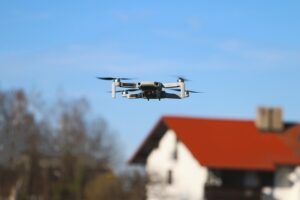
In 1946, a chicken farmer located outside of Greensboro, North Carolina named Thomas Lee Causby sued the United States. At the time, Causby’s farm was located near a military airport. Frequent flights over his property frightened and killed more than 150 of his chickens, forcing Causby to abandon his business. Causby argued that by using the airspace over his property, the government had seized his property without compensation, in violation of the Takings Clause of the 5th Amendment.
Continue reading below, or listen:
Given the damage to his property, Causby was granted compensation – and started an argument about property rights that continues to this day. At the AUVSI Xponential conference in Denver this week, a group of drone advocacy experts explained why the case is often incorrectly referenced – and how drone industry stakeholders can better communicate with state and local lawmakers to create reasonable state and local regulations regarding drone use in the airspace over private property.
Who Owns the Airspace Over My House?
Moderator Vic Moss and panelist Kenji Sugahara represent the Drone Service Providers Alliance; Scott Shtofman, AUVSI; David Heath, Pennsylvania Drone Association; and Rob Olson, the Illinois Drone Association. All have deep experience in working with local stakeholders who may be unaware of airspace regulations – and have real concerns over privacy, noise, and annoyance.
“I’ve heard Causby quoted a hundred times,” said Vic Moss. “But I’ve never heard it referenced correctly.” Kenji Sugahara explained the concept of FAA pre-emption, which says that the FAA regulates all airspace, from the ground up – period. While Causby won compensation, it wasn’t because the government wasn’t allowed to fly planes over his farm. “What’s interesting about the Causby case was that it was about nuisance, not about aviation,” he said. “At what altitude does the noise get so close that you can’t enjoy your property?”
In the Causby case, that limit was named at 83 feet: “The safe path of glide to one of the runways of the airport passed directly over respondents’ property at 83 feet, which was 67 feet above the house, 63 feet above the barn and 18 feet above the highest tree.” That doesn’t mean, however, that there is a legal precedence for banning flight at 83 feet altitude or lower, says Sugahara. “There is not arbitrary limit. You can’t regulate all of the airspace up to 200 feet… the FAA regulates the airspace. It’s a safety issue.”
Note: for those interested in more details on the case, full documents can be found here.
The “Sidewalk Argument”
David Heath says that he sometimes compares airspace access over a private home to the sidewalk access in front of the same home. “Drone do make aviation more intimate,” he says. “You have to think about it in terms of the sidewalk in front of your house: you can’t block off your sidewalk, you have to allow people public access,” he said.
“That’s not to say that you can hang out on someone’s sidewalk and do things that you aren’t supposed to do,” commented Moss. “And it’s the same with the airspace.”
“‘But the sidewalk doesn’t go right over my pool'” is a common response, said Rob Olson. “But really, planes are flying over your pool all of the time, just at a higher altitude.” When stakeholders express concern about privacy, Olson responds that laws about Peeping Toms or harassment already exist – it’s not necessary to write new rules specific to drones.
Making FAA Preemption Clear
With FAA Reauthorization on the horizon, all of the panelist agree that getting FAA preemption defined in that legislation would make it much easier to prevent restrictive state and local regulations. “It’s time to find your Senators,” said Moss.
Scott Shtofman says that AUVSI’s Hill day is one way of bringing the drone operator perspective to lawmakers. “Our members of Congress are interested in speaking with us,” he said. “We have interesting technology. Be engaged, be gracious, be polite – and be that smart person in the room who can provide solutions, and not just complaints.”
Read more:
- The FAA Stance on State Drone Regulation: Preemption is Still Preemption, But There’s a Loophole
- Figuring Out State and Local Drone Laws: Where to Find Them and How to Follow Them
- An Open Letter to State and Local Policy Makers
- AUVSI Launches Drone Prepared: Is Your State Ready for Drones?
- AUVSI’s Scott Shtofman on the Drone Radio Show Podcast! Legislative Opportunities for the Drone Industry
Miriam McNabb is the Editor-in-Chief of DRONELIFE and CEO of JobForDrones, a professional drone services marketplace, and a fascinated observer of the emerging drone industry and the regulatory environment for drones. Miriam has penned over 3,000 articles focused on the commercial drone space and is an international speaker and recognized figure in the industry. Miriam has a degree from the University of Chicago and over 20 years of experience in high tech sales and marketing for new technologies.
For drone industry consulting or writing, Email Miriam.
TWITTER:@spaldingbarker
Subscribe to DroneLife here.